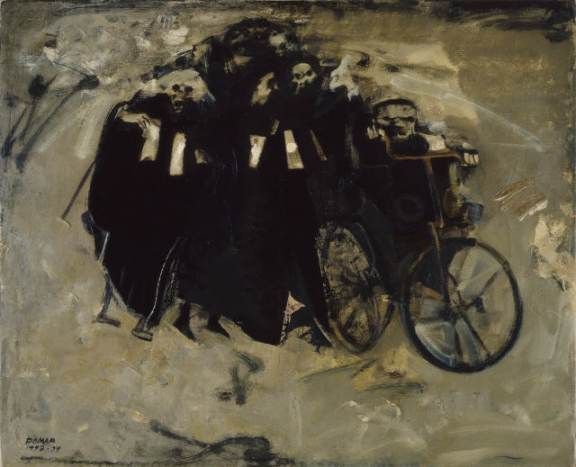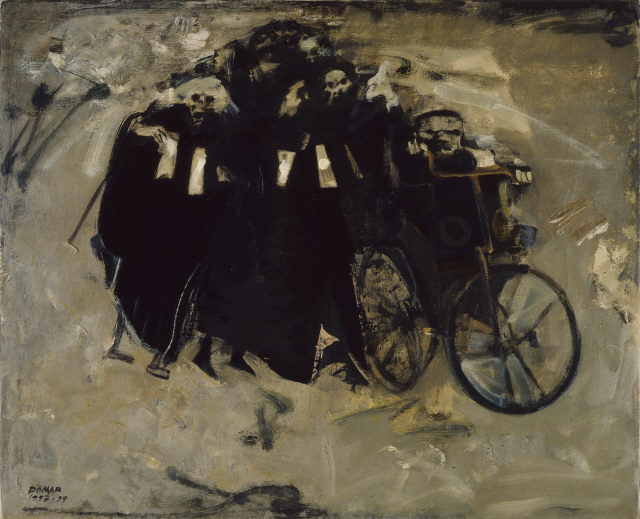
- 1957
- Canvas
- Oil
- Inv. 83P703
Júlio Pomar
Cegos de Madrid [The Blind of Madrid]
Following the painting Maria da Fonte (1957), this is one of the emblematic works that mark a turning point in Júlio Pomar's painting, after a period in which he worked through a more conventionally realist language. The impact of Goya's painting, which he first viewed in his first trip to Madrid in 1950, can be felt not only in these paintings, but also in his illustrations of the 1950's. These comprise a large part of his work in these years, and the technical exploration they gave rise to seem to have played an important role in the significant and permanent changes in his painting.* His experiences in illustration with the Japanese paintbrush he bought in Paris in 1956 appear to have been crucial in the adoption of the gestural brushstrokes that will mark his pictorial work from hence forth (although he did later embark on other technical incursions, such as in his use of acrylic and collage), forgoing the use of preparatory sketches.
Joining an already assimilated neo-realism with the influence of Goya and the colors of Portuguese painter Columbano Bordalo Pinheiro, and never abandoning the reference to reality, Pomar appropriated thus the expressionisms and gestualisms which at the time dominated the international landscape of painting. He chose a phrase from James Joyce as epigraph for these years (1959-1966): “Shut your eyes and see”.
The pyramid-like amorphous black block against which the cadaverous faces of the blind and the recipients to collect their alms sharply contrast in white impede any individualization of the human figures. The impossible orientation the blind seek by supporting themselves on each other's blindness turns them into a mass that is nevertheless the only recognizable form advancing from the amorphous background. One can’t help but be reminded of Bruegel’s 1568 painting, The Blind Leading the Blind, based on what Jesus said to the Pharisees: “Can the blind lead the blind? Will they not both fall into the ditch?” (Matthew 15:14). And, in The Blind of Madrid, the spectator, faced with this imminent fall, is condemned to blindness as well.
* This has also been noted by Alexandre Pomar, see “Júlio Pomar”, in: Júlio Pomar. Catalogue raisonné I: peintures, fers et assemblages, 1942-1968, Paris: La Différence / Artemágica, 2004, p. 21.
MPS
November 2010
| Type | Value | Unit | Section |
| Width | 101,3 | cm | |
| Height | 81,5 | cm | |
| Width | 104,5 | cm | |
| Depth | 4 | cm | |
| Height | 84,5 | cm |
| Type | date |
| Type | other |
| Type | signature |
| Type | Acquisition |
| 50 Anos de Arte Portuguesa |
| Lisboa, Fundação Calouste Gulbenkian, 2007 |
| ISBN:978-972-678-043-4 |
| Catálogo de exposição |
| Júlio Pomar: um artista português |
| São Paulo, Pinacoteca do Estado de São Paulo, 2008 |
| Catálogo de exposição |
| 50 Anos de Arte Portuguesa |
| Fundação Calouste Gulbenkian |
| Curator: Fundação Calouste Gulbenkian |
| 6 de Junho de 2007 a 9 de Setembro de 2007 Sede da FCG, Piso 0 e 01 |
| Exposição programada pelo Serviço de Belas-Artes e pelo Centro de Arte Moderna, da Fundação Calouste Gulbenkian.Comissariado: Raquel Henriques da Silva, Ana Ruivo e Ana Filipa Candeias |
| Júlio Pomar: um artista português |
| Pinacoteca do Estado de São Paulo |
| Curator: Hellmut Wohl |
| 5 de Abril de 2008 a 18 de Maio de 2008 Pinacoteca do Estado de São Paulo |
| Comissário da exposição Hellmut Wohl. |
| Autobiografia |
| Sintra Museu de Arte Moderna |
| Curator: Sintra Museu de Arte Moderna |
| 8 de Maio de 2004 a 28 de Novembro de 2004 Sintra Museu de Arte Moderna |
| Grande exposição de Júlio Pomar realizada pelo Sintra Museu da Arte Moderna com o apoio do Millennium BCP. |
| 4º Prémio Amadeo de Souza-Cardoso: Júlio Pomar |
| Museu Municipal Amadeo de Souza-Cardoso |
| Curator: Museu Municipal Amadeo de Souza-Cardoso |
| 13 de Setembro de 2003 a 2 de Novembro de 2003 Museu Municipal Amadeo de Souza-Cardoso |
| Exposição realizada no âmbito da atribuição do Prémio Amadeo de Souza-Cardoso ao Mestre Júlio Pomar. |
